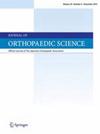Prevalence and associated factors for primary osteoarthritis of the thumb carpometacarpal joint in the general elderly population: A cohort survey randomly sampled from a basic resident registry of a small rural town in Japan
IF 1.4
4区 医学
Q3 ORTHOPEDICS
引用次数: 0
Abstract
Background
Osteoarthritis of the thumb carpometacarpal joint often presents pain and affects activity of daily life. There is no consensus regarding prevalence of primary radiographic osteoarthritis and symptomatic osteoarthritis of the thumb carpometacarpal joint, and their associated factors are not well investigated. The purpose of this study is to evaluate the prevalence and associated factors of primary radiographic and symptomatic osteoarthritis of the thumb carpometacarpal joint in a resident cohort.
Methods
A total of 1297 residents aged 50 to 89 were randomly sampled from a small rural town in Japan, and their demographic data and questionnaire regarding lifestyle and job were obtained. All participants underwent posteroanterior radiographs of the bilateral hands. Participants with thumb carpometacarpal joint radiographic osteoarthritis were diagnosed if one of their thumb carpometacarpal joints was Kellgren-Lawrence grade 2, 3, or 4. Symptomatic osteoarthritis was diagnosed by tenderness or positive motion pain at the thumb base. Associated factors for the thumb carpometacarpal joint radiographic osteoarthritis were statistically analyzed.
Results
A total of 646 thumbs with 323 participants (153 male and 170 female) were investigated. The mean age was 69.1 (range 50–89) years, The prevalence of thumb carpometacarpal joint radiographic osteoarthritis was 17.3 % (13.7 % males and 20.6 % females) and that of thumb carpometacarpal joint symptomatic osteoarthritis was 3.1 %. Associated factors for thumb carpometacarpal joint radiographic osteoarthritis were presence of finger joint radiographic osteoarthritis in the ipsilateral hand, increasing age, and female in order of degree of relevance. Dominant hand, body mass index, smoking history, heavy manual or agriculture work, use of vibrating tools, racket or bat sports, or scaphotapeziotrapezoidal joint radiographic osteoarthritis were not associated factors for thumb carpometacarpal joint radiographic osteoarthritis.
Conclusions
The prevalence of thumb carpometacarpal joint primary radiographic osteoarthritis in general Japanese elderly aged 50–89 years was 17.3 %, most of carpometacarpal joint radiographic osteoarthritis was asymptomatic.
普通老年人群中拇指腕掌关节原发性骨关节炎的患病率和相关因素:从日本一个农村小镇的基本居民登记册中随机抽取的队列调查。
背景:拇指腕掌关节骨关节炎通常会引起疼痛并影响日常生活活动。关于拇指腕掌关节原发性放射性骨关节炎和无症状性骨关节炎的患病率尚未达成共识,对其相关因素的调查也不充分。本研究旨在评估居民队列中拇指腕掌关节原发性放射性骨关节炎和症状性骨关节炎的患病率和相关因素:方法:从日本的一个农村小镇随机抽取了 1297 名年龄在 50-89 岁之间的居民,获得了他们的人口统计学数据以及有关生活方式和工作的调查问卷。所有参与者均接受了双侧手掌后正位X光片检查。如果参与者的拇指腕掌关节中的一个关节达到凯尔格伦-劳伦斯2级、3级或4级,则被诊断为拇指腕掌关节放射性骨关节炎。有症状的骨关节炎可通过拇指根部触痛或运动疼痛确诊。对拇指腕掌关节放射骨关节炎的相关因素进行了统计分析:共调查了 323 名参与者(男性 153 人,女性 170 人)的 646 根拇指。平均年龄为 69.1 岁(50-89 岁不等),拇指腕掌关节放射性骨关节炎的发病率为 17.3%(男性 13.7%,女性 20.6%),拇指腕掌关节症状性骨关节炎的发病率为 3.1%。拇指腕掌关节放射性骨关节炎的相关因素依次为同侧手存在手指关节放射性骨关节炎、年龄增加和女性。惯用手、体重指数、吸烟史、重体力劳动或农业劳动、使用振动工具、球拍或球棒运动、腕掌关节放射性骨关节炎不是拇指腕掌关节放射性骨关节炎的相关因素:在 50-89 岁的日本老年人中,拇指腕掌关节原发性放射性骨关节炎的发病率为 17.3%,大多数腕掌关节放射性骨关节炎没有症状。
本文章由计算机程序翻译,如有差异,请以英文原文为准。
求助全文
约1分钟内获得全文
求助全文
来源期刊

Journal of Orthopaedic Science
医学-整形外科
CiteScore
3.00
自引率
0.00%
发文量
290
审稿时长
90 days
期刊介绍:
The Journal of Orthopaedic Science is the official peer-reviewed journal of the Japanese Orthopaedic Association. The journal publishes the latest researches and topical debates in all fields of clinical and experimental orthopaedics, including musculoskeletal medicine, sports medicine, locomotive syndrome, trauma, paediatrics, oncology and biomaterials, as well as basic researches.
 求助内容:
求助内容: 应助结果提醒方式:
应助结果提醒方式:


